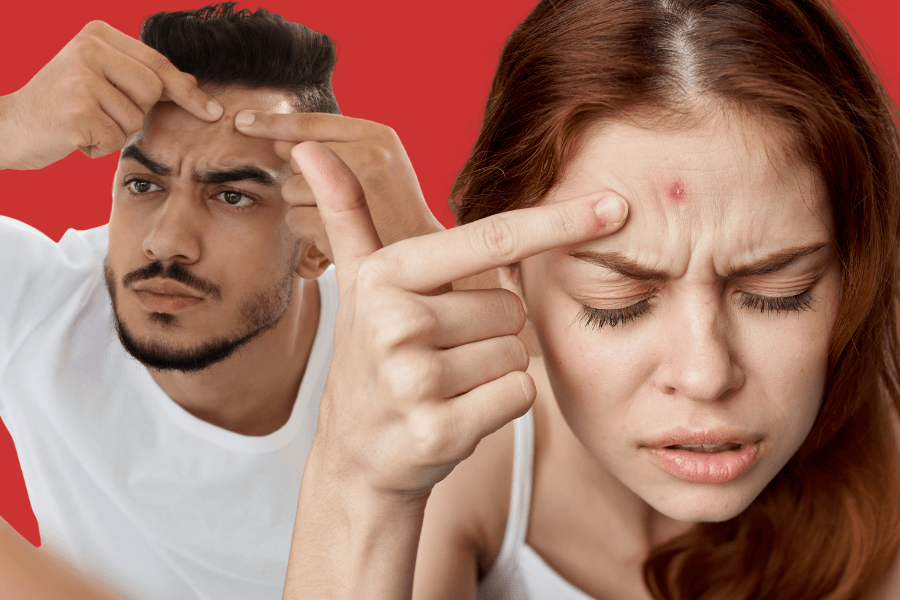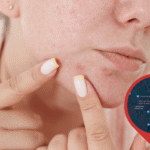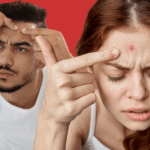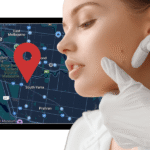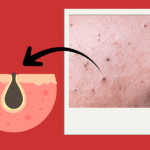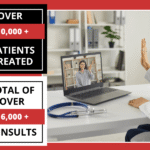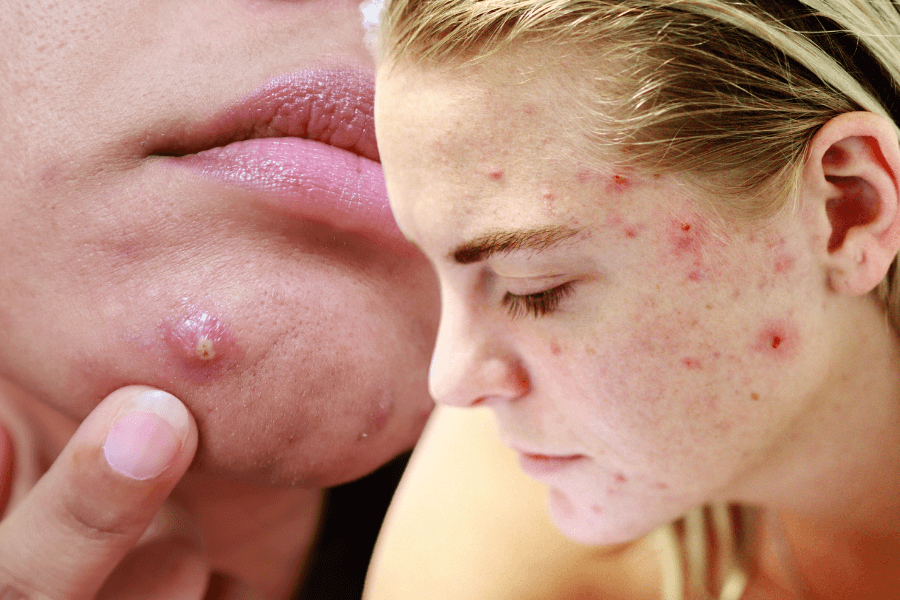
Ever had one of those mornings where you wake up and there’s a massive spot right on your chin? Understanding the different types of pimples can actually help you figure out what to do about them.
Your best mate gets the same type of breakout but theirs clears up in two days while yours hangs around for weeks? Yeah, acne‘s weird like that. The truth is, pimples aren’t all the same. Some are tiny and black, others are red and angry, and some are these massive painful lumps that make you want to hide under a rock.
What makes different types of spots?
Right, so your skin’s constantly making this oily stuff called sebum. Most of the time it does its job – keeps your skin from drying out. But sometimes your pores get blocked up with dead skin and oil, and that’s when things get interesting.
What type of pimple you end up with depends on loads of factors. How deep the blockage is, whether bacteria get involved, how your body reacts to it all. It’s a bit like cooking really – same ingredients but depending on what happens, you might get a soufflé or you might get a disaster.
The quiet types that don’t hurt much
Blackheads
These are probably the most common type of spot, especially if you’ve got oily skin. They look like tiny black dots, usually clustered around your nose and forehead. Despite what some people think, that black colour isn’t dirt – it’s the stuff in your pore turning dark when it hits the air, sort of like how an apple goes brown when you leave it out.
Blackheads can be proper stubborn. You can squeeze them out (not that you should, but we’ve all been there) and they’ll just come back in a few days. They’re not painful though, which is something.
Whiteheads
Whiteheads are basically blackheads with the top sealed over. Instead of that dark spot, you get a small white or skin-coloured bump. They’re usually smaller than other types of pimples but they can stick around for ages.
The annoying thing about whiteheads is they’re harder to treat because that closed pore means your skincare products can’t get in there as easily. They love appearing on your cheeks and around your eyes where the skin’s a bit thinner.
The red, angry ones
Papules
This is where spots start getting properly annoying. Papules are small red bumps that are sore when you touch them. They happen when bacteria get into your blocked pores and your body’s not having it, so everything gets inflamed.
These often show up in groups, making whole areas of your face look red and bumpy. The worst part is they look like they should have a head you can pop, but they don’t. Trying to squeeze them just makes them angrier and more inflamed.
Stress seems to make papules worse. Students often get them during exam periods, and they tend to flare up when life gets hectic.
Pustules
If a papule develops a white or yellow head, that’s a pustule. This is what most people think of as a "proper" pimple. That white bit is actually white blood cells that have rushed in to fight the infection – pretty gross when you think about it.
Pustules are really tempting to pop because of that obvious white head, but squeezing them spreads bacteria around and can cause more spots. Plus you might end up with permanent marks, which nobody wants.
The really painful ones
Nodules
Nodules are when acne gets serious. These form deep under your skin and create hard, painful lumps that can last for months. They don’t have a head like surface pimples – they’re just these sore bumps that hurt to touch.
These usually appear along your jawline and can be triggered by hormonal changes. Some people find them so painful they can’t even rest their face on their hand. Normal spot treatments don’t usually help much because they can’t get deep enough to where the problem is.
If you’re getting nodules regularly, it’s definitely worth seeing a dermatologist. They’ve got stronger treatments that can actually reach these deep spots.
Cysts
Cystic acne is the worst type you can get. These are large, soft lumps filled with pus that form really deep in your skin. They’re extremely painful and almost always leave scars if you don’t treat them properly.
What makes cysts particularly horrible is they can join up under your skin, creating these networks of inflammation that affect big areas of your face. They’re most common in hormonal acne and pretty much always need prescription treatment to clear up.
Anyone dealing with cystic acne shouldn’t try to handle it alone. Get professional help – it’s worth it to avoid permanent scarring.
Adult acne is a thing too
Here’s something nobody tells you as a teenager – acne doesn’t magically stop when you turn 20. Many adults get spots, especially women, and it’s often different from teenage acne.
Adult acne usually shows up along your jawline, chin, and neck. These areas are really sensitive to hormone changes, which is why some women notice their spots get worse at certain times of the month.
Adult spots tend to be the deeper, more stubborn types like nodules and cysts rather than the surface blackheads and whiteheads that teenagers get. It’s frustrating because you think you’ve left all that behind, then suddenly you’re 30 and dealing with painful spots again.
When you should see a doctor
Look, nobody likes admitting they need help with their skin, but sometimes you’ve just got to accept that over-the-counter stuff isn’t going to cut it. You should definitely consider seeing a dermatologist if:
- You’re getting painful nodules or cysts
- Your spots are leaving permanent marks or scars
- You’ve been using shop-bought treatments for months and nothing’s working
- Your acne is making you feel rubbish about yourself
There’s nothing embarrassing about getting professional help. Dermatologists have access to proper prescription treatments that actually work, instead of all the overpriced rubbish you can buy at the chemist.
So what actually works then?
This is where it gets a bit complicated. Your cousin swears by tea tree oil, your sister’s obsessed with some expensive serum, and that influencer on TikTok reckons lemon juice is the answer. Meanwhile, you’ve tried half of Priceline and still wake up with new spots.
Here’s the thing – blackheads and whiteheads are usually the easiest to sort out. A decent cleanser and maybe some gentle exfoliation can work wonders. Nothing fancy, just consistent routine stuff.
The deeper, angrier spots though? That’s where it gets tricky. These usually laugh in the face of your regular skincare routine. Most people end up needing something stronger from a doctor.
And can we talk about patience for a minute? Because this is probably the most annoying part of treating acne. You want results yesterday, but your skin’s working on geological time. Even the good treatments take forever – we’re talking 2-3 months before you see proper results. Those "clear skin in 7 days" ads are taking the piss, frankly.
Oh, and here’s something nobody warns you about – sometimes your skin gets worse before it gets better. Especially with prescription treatments. It’s like your spots are having one last hurrah before they bugger off. Annoying as hell when you’re already self-conscious.
Let’s be realistic about this whole thing
Look, knowing what type of spots you’ve got is actually pretty useful. Not just for pub quiz trivia, but because different types need different approaches. Trying to treat cystic acne with the same stuff you’d use for blackheads is like trying to fix a broken leg with a plaster.
The beauty industry loves flogging us miracle cures and magic potions, but honestly? Most effective acne treatment is dead boring. It’s about finding products that work for your specific skin type and using them religiously for months. Not very Instagram-worthy, but there you go.
Here’s what really winds us up though – people who say "oh, acne’s just part of growing up" or "you’ll grow out of it." Absolute nonsense. There are treatments that work for every type of acne, from the mildest blackheads to the nastiest cysts. Nobody should have to put up with painful, scarring spots just because some people think it’s normal.
Sometimes finding the right treatment takes ages and feels like a proper mission. But it’s worth sticking with it because clear skin is definitely achievable, even if it doesn’t happen overnight like the ads promise.
Disclaimer: The information provided in this article is for educational and informational purposes only and is not intended as medical advice, diagnosis, or treatment. This content should not be used as a substitute for professional medical consultation, diagnosis, or treatment.
While we strive to provide accurate and up-to-date information, medical knowledge is constantly evolving, and individual cases may vary significantly. The conditions, treatments, and recommendations discussed in this article may not be suitable for everyone.
Do not delay seeking professional medical advice because of information you have read in this article. If you experience severe symptoms, allergic reactions, or medical emergencies, seek immediate medical attention.
The authors and publishers of this content disclaim any liability for adverse effects or consequences resulting from the use of the information presented herein. Individual results may vary, and what works for one person may not work for another.


